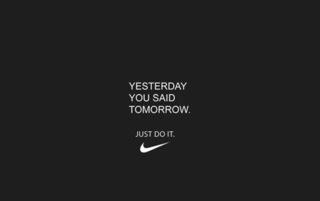
Think Less, DO More
July 19, 2012 // Wellness
Goals of health and wellness are generally brought upon after a problem is recognized and accepted. Thoughts such as “I need to lose some weight before summer starts” and “I want to add muscle on my flabby arms” become established as passive goals. Passive goals are thoughts of creating a change without a plan of action. Too often, people create passive goals in hopes of improved health but never take the appropriate steps to bring these goals to life. Reasons for inaction include:
*Information Overload (Excess information on a given subject)
*Unrealistic Goals (Results seem impossible)
*Loss of Motivation (Lack of support or structure)
*Lifestyle Interference (Conflicts with habits and routines)

I’ll Start Tomorrow
The most powerful statement of motivation is “Nothing To Lose”. When a person sees past excuses and fears, their potential is immeasurable. Ironically, the same motivation is brought about when someone is faced with an impending loss of something valuable, such as loss of life (“Everything To Lose“). Both motivations occur when an absolute is met and there are no other options. With health and wellness, motivation can quickly fade without a system of absolutes. Absolutes are necessary when structuring a change, whether a loss or gain. Below are examples of passive goals and health absolutes:
Passive Goal: I really need to cut back on the wine.
Absolute: Limit alcohol drinks to three (3) per week
Passive Goal: I wish my thighs looked better.
Absolute: I will workout legs at least twice every week using Resistance training.
Passive Goal: I need to get control of my eating habits.
Absolute: Sign up for a nutritional support system starting Monday, July 30th.
Passive Goal: I want a flat stomach.
Absolute: Limit eating starches/grains to two (2) meals a day.
Track records and logs are great ways to ensure self-accountability. Self-Accountability is one of the most important factors in health. Birthdays. Fourth of July parties. Vacations. Weekend Getaways. Busy at work. Friends in town. Summertime. There are an endless amount of excuses someone can use to avoid exercise and effective eating habits. Without self-accountability, it is unrealistic to expect someone to stay focused and dedicated to their goal(s). Making short-term checkpoints are a great way to stay compliant to an established strategy. Here’s an example of outlining goals:
Goal: I want a flat stomach within a month, so I am going to limit eating starches and grains to two (2) meals a day.
Task 1: Take Day 1 photographs of my body and stomach.
Task 1: Determine which daily meals I struggle with the most.
Task 2: Determine what other foods I can substitute for the starches and grains of these two (2) meals.
Task 3: Keep a log of the two meals I modify so I can always refer back to my progress records.
Task 4: Review my log every Sunday to make sure I am still on track.
Task 5: Take photographs every Friday to compare the aesthetic changes week-to-week.
THINK<—————————————————————————————> DO!
THINK: Read, Brainstorm, Research, Plan, Strategize, Outline
DO: Carrying out the steps, Walking the walk, Putting in the work
DO SOMETHING!
Most people have trouble seeing the road to success when establishing a goal. We spend so much time and effort on the THINK side that we don’t even make it to DO! The action and physical efforts are ultimately the most important step in achieving a goal. Whether it is outlining your steps to success or walking into the gym, do not hesitate to make the first step. If something is important to you, make the effort. Waiting only delays your progress and deters your focus to success.
